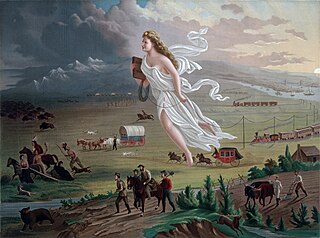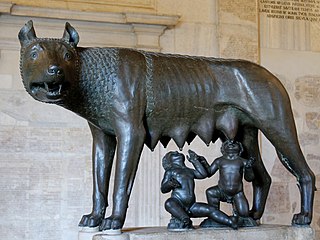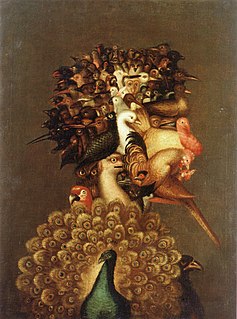 W
WThe Allegory of Prudence is an oil-on-canvas painting attributed to the Italian artist Titian and his assistants. The painting portrays three human heads, each facing in a different direction, above three animal heads. It is in the National Gallery, London.
 W
WAmerican Progress is an 1872 painting by John Gast, a Prussian-born painter, printer, and lithographer who lived and worked most of his life in Brooklyn, New York. American Progress, an allegory of Manifest Destiny, was widely disseminated in chromolithographic prints. It is now held by the Autry Museum of the American West in Los Angeles, California.
 W
WThe Animal Wall is a sculptured wall depicting 15 animals in the Castle Quarter of the city centre of Cardiff, Wales. It stands to the west of the entrance to Cardiff Castle, having been moved from its original position in front of the castle in the early 1930s. The design for the wall was conceived by William Burges, architect to the third Marquess of Bute, during Burges's reconstruction of the castle in the 1860s, but it was not executed until the late 1880s/early 1890s. This work, which included the original nine animal sculptures, all undertaken by Burges's favourite sculptor, Thomas Nicholls, was carried out under the direction of William Frame, who had previously assisted Burges at both Cardiff Castle and at Castell Coch. When the wall was moved in the early 20th century, the fourth Marquess commissioned Alexander Carrick to carve a further six sculptures to sit on the extended wall which now fronted Bute Park. The Animal Wall is a Grade I listed structure.
 W
WThe Capitoline Wolf is a bronze sculpture depicting a scene from the legend of the founding of Rome. The sculpture shows a she-wolf suckling the mythical twin founders of Rome, Romulus and Remus. According to the legend, when King Numitor, grandfather of the twins, was overthrown by his brother Amulius in Alba Longa, the usurper ordered them to be cast into the Tiber River. They were rescued by a she-wolf that cared for them until a herdsman, Faustulus, found and raised them.
 W
WThe Capitoline Wolf Statue is a sculpture of a she-wolf nursing Romulus and Remus in Cincinnati, Ohio, United States. The bronze sculpture on a granite and marble base is located in Eden Park at the Twin Lakes area overlooking the Ohio River. It is an exact replica of the original Capitoline Wolf in the Musei Capitolini of Rome, Italy.
 W
WThe Capitoline Wolf Statue in Cluj-Napoca, Romania is located on Eroilor Boulevard, in the city centre on the banks of the Someșul Mic River.
 W
WThe Capitoline Wolf suckling the twins Romulus and Remus is a symbol of Rome, Italy. The statue was favoured by Italian dictator Benito Mussolini, who donated copies of the statues to various places around the world.
 W
WThe Capitoline Wolf is a monument in Central Chișinău, Moldova. It is located in front of the National History Museum of Moldova.
 W
WExpulsion from the Garden of Eden was painted in 1828 by English-born American painter Thomas Cole. It belongs to the collection of the Museum of Fine Arts, Boston and is on display in their Waleska Evans James Gallery. This landscape painting exemplifies the style of the Hudson River School, which was a group of American landscape painters that Thomas Cole is credited with founding. On the lower left part of the cliff, Cole signed his name as "T Cole".
 W
WThe Four Elements is a series of four oil paintings by the Italian artist Giuseppe Arcimboldo which were created in 1566, during the Renaissance, for Maximilian II, Holy Roman Emperor. The paintings depict human faces in profile made up from different animals or objects. Air is represented by birds, Fire by burning wood and cannons, Earth by land animals and Water by marine creatures. The series attempts to express the creation of harmony from chaos by the careful arrangement of the wild animals to form portraits whilst also praising Maximilian by suggesting that he is a ruler who controls even the four primal elements.
 W
WThe Fonte Gaia is a monumental fountain located in the Piazza del Campo in the center of Siena, Italy.
 W
WThe Quattro Fontane is an ensemble of four Late Renaissance fountains located at the intersection of Via delle Quattro Fontane and Via del Quirinale in Rome. They were commissioned by Pope Sixtus V and built at the direction of Muzio Mattei, and were installed between 1588 and 1593. The figure of one fountain is said to represent the River Tiber, in front of an oak-tree; a she-wolf, the symbol of Rome, was a later addition. A second fountain represents the River Aniene, a tributary of the Tiber, called Anio in ancient Rome, which provided most Roman aqueducts with water. Pope Sixtus proposed to build a canal to bring the water of the Aniene to Rome. The other two fountains feature female figures believed to represent the Goddess Diana; the symbol of Chastity; and the Goddess Juno, the symbol of Strength, but it is possible that they may also represent rivers. The fountains of the Aniene, Tiber, and Juno are the work of Domenico Fontana. The fountain of Diana was designed by the painter and architect Pietro da Cortona.
 W
WRomulus and Remus is a painting by the Flemish artist Peter Paul Rubens. It is housed in the Pinacoteca Capitolina in Rome, Italy. It depicts the brothers Romulus and Remus being cared for by a wolf. The painting also shows the god of the Tiber river sitting on his urn, a woodpecker that watched over the twins to bring them food, and a shepherd discovering the infants.
 W
WThe Sacagawea dollar is a United States dollar coin first minted in 2000, although not minted for general circulation between 2002 to 2008 and again from 2012 onward due to its general unpopularity with the public and low business demand for the coin. These coins have a copper core clad by manganese brass, giving them a distinctive golden color. The coin features an obverse by Glenna Goodacre. From 2000 to 2008, the reverse featured an eagle design by Thomas D. Rogers. Since 2009, the reverse of the Sacagawea dollar has been changed yearly, with each design in the series depicting a different aspect of Native American cultures. These coins are marketed as "Native American dollars".
 W
WVictoria Centennial Fountain, also known as Back Fountain or simply Centennial Fountain, is installed outside the British Columbia Parliament Buildings in Victoria, British Columbia. The fountain was designed by Robert Savery in 1962, and commemorates the four colonies and territories that formed British Columbia. The bronze sculptures of a bear, eagle, gull, sea otter, raven, and wolf represent the province's geography and history.
 W
WThe Wolf and Fox Hunt is a c.1616 painting by Peter Paul Rubens now held in the Metropolitan Museum of Art in New York. It shows mounted and walking hunters chasing two wolves and three foxes. It marks the beginning of an intensive creative phase in which Rubens focuses on the theme of hunting.
 W
WThe Wolf of Gubbio is an 1877 oil on canvas painting by Luc-Olivier Merson, dedicated to his former student, collaborator and friend Adolphe Giraldon and exhibited at the Paris Salon of 1878. It was acquired by its present owner, the Palais des Beaux-Arts de Lille, in 1881. It is inspired by a legend of Francis of Assisi and the wolf of Gubbio in Italy.
 W
WThe wolf has been widely used in many forms in heraldry during the Middle Ages. Though commonly reviled as a livestock predator and man-eater, the wolf was also considered a noble and courageous animal, and frequently appeared on the arms and crests of numerous noble families. It typically symbolised the rewards of perseverance in long sieges or hard industry.